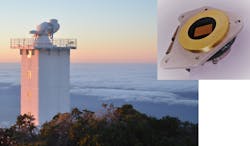Four InGaAs sensor modules form a 12 Mpixel SWIR camera for the Swedish Solar Telescope
Imaging and laser device maker SemiConductor Devices (SCD; Misgav, Israel) has delivered an imaging sensor made up of four large-format, 1920 × 1536 pixel, 10 µm pitch indium gallium arsenide (InGaAs) shortwave-infrared (SWIR) focal-plane array (FPA) modules that together form a one-of-a-kind 12 Mpixel sensor (one of the modules is shown in the figure). The device will be mounted on an instrument built by the Max Planck Institute for Solar System Research in Göttingen, Germany, and further on will be installed on the 1 m Swedish Solar Telescope (SST) on the island of La Palma, Spain.
Following integration with the SCD SWIR sensors, the SST will be the first solar telescope using hyperspectral imaging (simultaneously observing a spectral section in each pixel of an image). The large size and high frame rate of SCD SWIR sensors are essential for this imaging technique. The SST is the second largest optical solar telescope in Europe; the location of the telescope on La Palma as well as the use of adaptive mirror technology and image reconstruction techniques that correct for the blurring caused by the Earth's atmosphere at high frame rates enable optimal performance.
The InGaAs sensor has advanced characteristics such as in-pixel laser detection, very low light-level operation modes, extra-low floor noise, and 10 μm pixels coupled to a digital-readout IC architecture for video-rate stitching, notes Dan Slasky, CEO of SCD. The SST has a refractive primary that is 1.1 m in diameter with a clear aperture diameter of 0.98 m; its beam can be directed either to a spectrograph or to imaging apparatus. The telescope has an internal vacuum to minimize image degradation from heating. See scd.co.il and su.se/isf.
About the Author
John Wallace
Senior Technical Editor (1998-2022)
John Wallace was with Laser Focus World for nearly 25 years, retiring in late June 2022. He obtained a bachelor's degree in mechanical engineering and physics at Rutgers University and a master's in optical engineering at the University of Rochester. Before becoming an editor, John worked as an engineer at RCA, Exxon, Eastman Kodak, and GCA Corporation.

